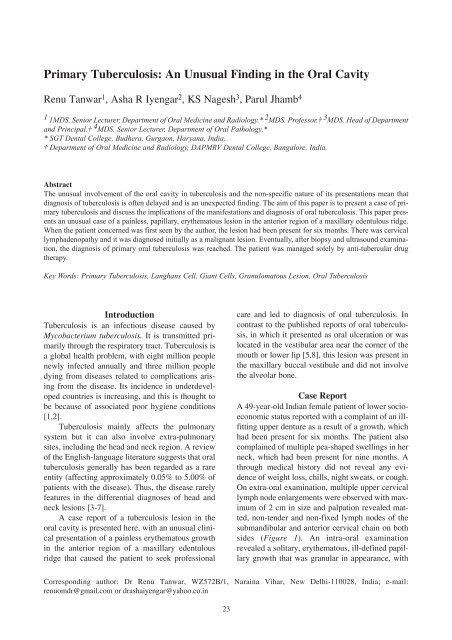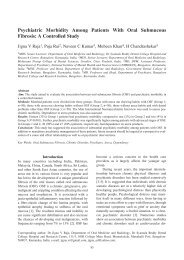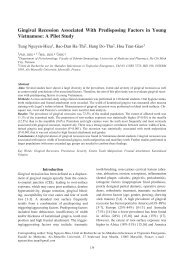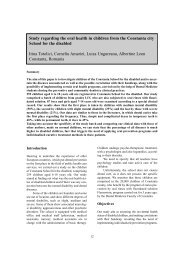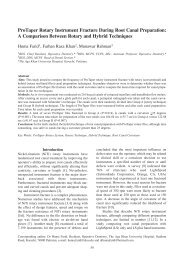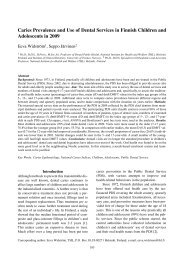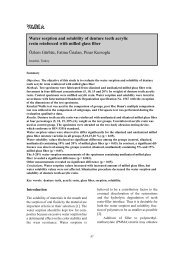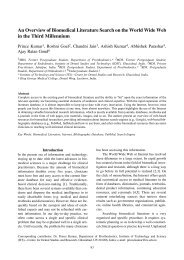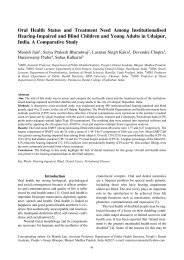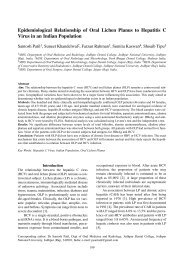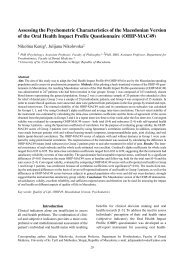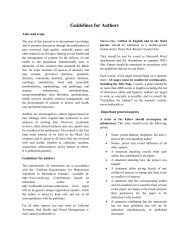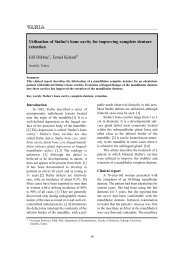Primary Tuberculosis: An Unusual Finding in the Oral Cavity
Primary Tuberculosis: An Unusual Finding in the Oral Cavity
Primary Tuberculosis: An Unusual Finding in the Oral Cavity
Create successful ePaper yourself
Turn your PDF publications into a flip-book with our unique Google optimized e-Paper software.
<strong>Primary</strong> <strong>Tuberculosis</strong>: <strong>An</strong> <strong>Unusual</strong> <strong>F<strong>in</strong>d<strong>in</strong>g</strong> <strong>in</strong> <strong>the</strong> <strong>Oral</strong> <strong>Cavity</strong><br />
Renu Tanwar 1 , Asha R Iyengar 2 , KS Nagesh 3 , Parul Jhamb 4<br />
1 1MDS. Senior Lecturer, Department of <strong>Oral</strong> Medic<strong>in</strong>e and Radiology.* 2 MDS. Professor.† 3 MDS. Head of Department<br />
and Pr<strong>in</strong>cipal.† 4 MDS. Senior Lecturer, Department of <strong>Oral</strong> Pathology.*<br />
* SGT Dental College, Budhera, Gurgaon, Haryana, India.<br />
† Department of <strong>Oral</strong> Medic<strong>in</strong>e and Radiology, DAPMRV Dental College, Bangalore, India.<br />
Abstract<br />
The unusual <strong>in</strong>volvement of <strong>the</strong> oral cavity <strong>in</strong> tuberculosis and <strong>the</strong> non-specific nature of its presentations mean that<br />
diagnosis of tuberculosis is often delayed and is an unexpected f<strong>in</strong>d<strong>in</strong>g. The aim of this paper is to present a case of primary<br />
tuberculosis and discuss <strong>the</strong> implications of <strong>the</strong> manifestations and diagnosis of oral tuberculosis. This paper presents<br />
an unusual case of a pa<strong>in</strong>less, papillary, ery<strong>the</strong>matous lesion <strong>in</strong> <strong>the</strong> anterior region of a maxillary edentulous ridge.<br />
When <strong>the</strong> patient concerned was first seen by <strong>the</strong> author, <strong>the</strong> lesion had been present for six months. There was cervical<br />
lymphadenopathy and it was diagnosed <strong>in</strong>itially as a malignant lesion. Eventually, after biopsy and ultrasound exam<strong>in</strong>ation,<br />
<strong>the</strong> diagnosis of primary oral tuberculosis was reached. The patient was managed solely by anti-tubercular drug<br />
<strong>the</strong>rapy.<br />
Key Words: <strong>Primary</strong> <strong>Tuberculosis</strong>, Langhans Cell, Giant Cells, Granulomatous Lesion, <strong>Oral</strong> <strong>Tuberculosis</strong><br />
Introduction<br />
<strong>Tuberculosis</strong> is an <strong>in</strong>fectious disease caused by<br />
Mycobacterium tuberculosis. It is transmitted primarily<br />
through <strong>the</strong> respiratory tract. <strong>Tuberculosis</strong> is<br />
a global health problem, with eight million people<br />
newly <strong>in</strong>fected annually and three million people<br />
dy<strong>in</strong>g from diseases related to complications aris<strong>in</strong>g<br />
from <strong>the</strong> disease. Its <strong>in</strong>cidence <strong>in</strong> underdeveloped<br />
countries is <strong>in</strong>creas<strong>in</strong>g, and this is thought to<br />
be because of associated poor hygiene conditions<br />
[1,2].<br />
<strong>Tuberculosis</strong> ma<strong>in</strong>ly affects <strong>the</strong> pulmonary<br />
system but it can also <strong>in</strong>volve extra-pulmonary<br />
sites, <strong>in</strong>clud<strong>in</strong>g <strong>the</strong> head and neck region. A review<br />
of <strong>the</strong> English-language literature suggests that oral<br />
tuberculosis generally has been regarded as a rare<br />
entity (affect<strong>in</strong>g approximately 0.05% to 5.00% of<br />
patients with <strong>the</strong> disease). Thus, <strong>the</strong> disease rarely<br />
features <strong>in</strong> <strong>the</strong> differential diagnoses of head and<br />
neck lesions [3-7].<br />
A case report of a tuberculosis lesion <strong>in</strong> <strong>the</strong><br />
oral cavity is presented here, with an unusual cl<strong>in</strong>ical<br />
presentation of a pa<strong>in</strong>less ery<strong>the</strong>matous growth<br />
<strong>in</strong> <strong>the</strong> anterior region of a maxillary edentulous<br />
ridge that caused <strong>the</strong> patient to seek professional<br />
care and led to diagnosis of oral tuberculosis. In<br />
contrast to <strong>the</strong> published reports of oral tuberculosis,<br />
<strong>in</strong> which it presented as oral ulceration or was<br />
located <strong>in</strong> <strong>the</strong> vestibular area near <strong>the</strong> corner of <strong>the</strong><br />
mouth or lower lip [5,8], this lesion was present <strong>in</strong><br />
<strong>the</strong> maxillary buccal vestibule and did not <strong>in</strong>volve<br />
<strong>the</strong> alveolar bone.<br />
Case Report<br />
A 49-year-old Indian female patient of lower socioeconomic<br />
status reported with a compla<strong>in</strong>t of an illfitt<strong>in</strong>g<br />
upper denture as a result of a growth, which<br />
had been present for six months. The patient also<br />
compla<strong>in</strong>ed of multiple pea-shaped swell<strong>in</strong>gs <strong>in</strong> her<br />
neck, which had been present for n<strong>in</strong>e months. A<br />
through medical history did not reveal any evidence<br />
of weight loss, chills, night sweats, or cough.<br />
On extra-oral exam<strong>in</strong>ation, multiple upper cervical<br />
lymph node enlargements were observed with maximum<br />
of 2 cm <strong>in</strong> size and palpation revealed matted,<br />
non-tender and non-fixed lymph nodes of <strong>the</strong><br />
submandibular and anterior cervical cha<strong>in</strong> on both<br />
sides (Figure 1). <strong>An</strong> <strong>in</strong>tra-oral exam<strong>in</strong>ation<br />
revealed a solitary, ery<strong>the</strong>matous, ill-def<strong>in</strong>ed papillary<br />
growth that was granular <strong>in</strong> appearance, with<br />
Correspond<strong>in</strong>g author: Dr Renu Tanwar, WZ572B/1, Nara<strong>in</strong>a Vihar, New Delhi-110028, India; e-mail:<br />
renuomdr@gmail.com or drashaiyengar@yahoo.co.<strong>in</strong><br />
23
OHDM - Vol. 11 - No. 1 - March, 2012<br />
dimensions of 1 cm x 3 cm. It was located <strong>in</strong> <strong>the</strong><br />
maxillary facial vestibule and extended along <strong>the</strong><br />
edentulous ridge from 14 to 24. It obliterated <strong>the</strong><br />
vestibule and did not <strong>in</strong>volve <strong>the</strong> maxillary ridge<br />
superio-<strong>in</strong>feriorly (Figure 2a and b). The surface of<br />
<strong>the</strong> growth was sh<strong>in</strong>y; no bleed<strong>in</strong>g, ulceration, or<br />
pus dra<strong>in</strong>age were observed. It was not tender and<br />
was soft <strong>in</strong> consistency when palpated.<br />
She had not taken any medication for <strong>the</strong> lesion.<br />
Her family history was non-relevant. Rout<strong>in</strong>e<br />
haematological and biochemical <strong>in</strong>vestigations and<br />
a chest radiograph were undertaken on <strong>the</strong> day that<br />
<strong>the</strong> patient reported to <strong>the</strong> department; <strong>the</strong>y did not<br />
reveal any abnormality. No radiographic evidence<br />
of <strong>in</strong>volvement of underly<strong>in</strong>g bone was seen on an<br />
occlusal radiograph. Ultrasound exam<strong>in</strong>ation of <strong>the</strong><br />
enlarged lymph nodes was performed three days<br />
after <strong>the</strong> first visit of <strong>the</strong> patient. It revealed hyperechoic,<br />
matted lymph nodes, suggestive of tuberculosis<br />
(Figure 3).<br />
Figure 1. Cervical lymphadenitis.<br />
Figure 3. Ultrasound picture of left cervical<br />
lymph nodes.<br />
Figure 2 a, b. Ery<strong>the</strong>mous growth <strong>in</strong> maxillary<br />
facial vestibule.<br />
The patient gave a past dental history of<br />
extraction of upper front teeth one year previously.<br />
Three weeks after <strong>the</strong> first visit, serological<br />
tests were performed for syphilis and human<br />
immunodeficiency virus (HIV), toge<strong>the</strong>r with a<br />
sputum exam<strong>in</strong>ation, <strong>in</strong>clud<strong>in</strong>g Zielh–Neelsen<br />
sta<strong>in</strong><strong>in</strong>g. They gave negative results. Biopsy of <strong>the</strong><br />
<strong>in</strong>tra-oral lesion was <strong>the</strong>n undertaken. The subsequent<br />
histopathological exam<strong>in</strong>ation showed stratified<br />
squamous epi<strong>the</strong>lium and connective tissue,<br />
reveal<strong>in</strong>g crush<strong>in</strong>g artifacts, with <strong>the</strong> presence of<br />
multiple necrotis<strong>in</strong>g epi<strong>the</strong>lioid cell tuberculous<br />
granuloma and Langhans type of giant cell (Figure<br />
4). Acid-fast bacteria (AFB) sta<strong>in</strong><strong>in</strong>g was also<br />
found to be negative <strong>in</strong> <strong>the</strong> biopsy specimen.<br />
The patient was referred to Department of<br />
General Medic<strong>in</strong>e at <strong>the</strong> General Hospital <strong>in</strong><br />
Bangalore and a multidrug anti-tubercular regimen<br />
was started. This anti-tubercular <strong>the</strong>rapeutic regimen<br />
was adm<strong>in</strong>istered for six months and followup<br />
showed complete resolution of <strong>the</strong> oral lesion<br />
with no recurrence after two years, suggest<strong>in</strong>g a<br />
successful outcome.<br />
24
OHDM - Vol. 11 - No. 1 - March, 2012<br />
The patient gave written consent for her photographs<br />
and those of <strong>the</strong> lesion and its histopathological<br />
images to be used <strong>in</strong> this case report.<br />
Figure 4. Langhans giant cell conta<strong>in</strong><strong>in</strong>g nuclei<br />
arranged <strong>in</strong> a horseshoe-shaped pattern at cell<br />
periphery.<br />
The anti-tuberculous regimen for <strong>the</strong> patient<br />
was as follows. In <strong>the</strong> <strong>in</strong>itial phase, <strong>the</strong> follow<strong>in</strong>g<br />
drugs were given for two months: ethambutol<br />
hydrochloride (E): 500 mg, twice daily; isoniazid<br />
(INH): 150 mg, twice daily; pyraz<strong>in</strong>amide (Z): 750<br />
mg, twice daily; rifampic<strong>in</strong> (RIF): 300 mg, twice<br />
daily. The <strong>in</strong>itial phase was followed by cont<strong>in</strong>uation<br />
phase which dur<strong>in</strong>g which <strong>the</strong> follow<strong>in</strong>g drugs<br />
were given for a fur<strong>the</strong>r four months: INH: 150 mg,<br />
twice daily; RIF: 300 mg, twice daily.<br />
Dur<strong>in</strong>g follow-up, <strong>the</strong> size of enlarged lymph<br />
nodes reduced from 2 cm to 1 cm after <strong>the</strong> first three<br />
months of treatment and were of normal size after<br />
one year. The size of <strong>in</strong>tra-oral lesion reduced and<br />
<strong>the</strong>n completely healed. Six months after <strong>the</strong> completion<br />
of anti-tuberculous <strong>the</strong>rapy, <strong>the</strong> patient was<br />
referred to Department of Prosthodontics for <strong>the</strong> construction<br />
of a new denture. No recurrence of <strong>the</strong><br />
lesion was observed <strong>in</strong> <strong>the</strong> follow-up period of two<br />
years after completion of drug regimen (Figure 5).<br />
Figure 5. Resolved oral mucosal lesion after antitubercular<br />
<strong>the</strong>rapy.<br />
Discussion<br />
Tuberculous <strong>in</strong>volvement of <strong>the</strong> oral cavity is<br />
extremely rare, with <strong>in</strong>cidence rang<strong>in</strong>g from<br />
0.05%-5.00% [4,9]. Tuberculous lymphadenitis<br />
constitutes a component of head and neck disease<br />
<strong>in</strong> up to 90% of patients and presents as s<strong>in</strong>gle or<br />
multiple enlarged lymph nodes that may be firm,<br />
fluctuant, or matted with fistula formation [5,9-11].<br />
The World Health Organization (WHO) estimates<br />
approximately 20 million active cases of<br />
tuberculosis, 80% of which occur <strong>in</strong> <strong>the</strong> develop<strong>in</strong>g<br />
countries. The regions with <strong>the</strong> highest <strong>in</strong>cidence of<br />
tuberculosis are <strong>the</strong> Indian subcont<strong>in</strong>ent, South-<br />
East Asia, and Africa. The epidemiology of tuberculosis<br />
differs considerably with ethnicity. Age has<br />
also been implicated as an important risk factor, as<br />
well as differ<strong>in</strong>g ethnic and socio-economic group<strong>in</strong>g<br />
[12]. Poorer populations are twice as likely to<br />
have tuberculosis and three times less likely to<br />
access care for this disease [13].<br />
<strong>Oral</strong> tuberculosis most commonly results from<br />
contact of <strong>the</strong> oral tissues with <strong>in</strong>fected sputum or<br />
haematogenous dissem<strong>in</strong>ation <strong>in</strong> an older <strong>in</strong>dividual<br />
with pulmonary disease. In contrast, cases of<br />
primary <strong>in</strong>fection aris<strong>in</strong>g through direct mucosal<br />
<strong>in</strong>vasion by mycobacteria are uncommon and typically<br />
are seen <strong>in</strong> young patients, who often present<br />
with cervical lymphadenopathy with or without<br />
cutaneous s<strong>in</strong>us formation [6]. <strong>An</strong> <strong>in</strong>tact and<br />
healthy oral mucosa seems to provide a sufficient<br />
barrier to mycobacteria, with saliva also help<strong>in</strong>g to<br />
control <strong>the</strong> organisms [8].<br />
The sites demonstrat<strong>in</strong>g <strong>the</strong> most frequent<br />
<strong>in</strong>volvement with primary tuberculosis are <strong>the</strong> g<strong>in</strong>givae,<br />
vestibular mucosa, and extraction sockets.<br />
Mucosal lacerations and dental extractions have<br />
been implicated as predispos<strong>in</strong>g an <strong>in</strong>dividual to<br />
<strong>the</strong> development of oral tuberculosis [7].<br />
Traditionally, <strong>the</strong> diagnosis of tuberculosis has<br />
been made on <strong>the</strong> basis of cl<strong>in</strong>ical and radiographic<br />
f<strong>in</strong>d<strong>in</strong>gs. The diagnosis of orofacial tuberculosis<br />
can be quite challeng<strong>in</strong>g, ma<strong>in</strong>ly because of a lack<br />
of def<strong>in</strong>ite signs and symptoms. Accord<strong>in</strong>g to<br />
Pandit et al. (1995), when consider<strong>in</strong>g <strong>the</strong> overall<br />
prevalence of tuberculosis <strong>in</strong> <strong>the</strong> Indian population,<br />
<strong>the</strong> presence of epi<strong>the</strong>lioid cell granuloma is <strong>in</strong>dicative<br />
of <strong>the</strong> disease unless proven o<strong>the</strong>rwise, which<br />
is similar to our f<strong>in</strong>d<strong>in</strong>gs. It is also reported that <strong>the</strong><br />
25
OHDM - Vol. 11 - No. 1 - March, 2012<br />
percentage of cases show<strong>in</strong>g AFB positivity<br />
decl<strong>in</strong>es when more epi<strong>the</strong>lioid cell granulomas are<br />
observed [14].<br />
Dimitrakopoulos et al. (1991) reported two<br />
cases of primary tuberculosis of <strong>the</strong> oral cavity<br />
where smears and culture for AFB, from <strong>the</strong> oral<br />
lesion and <strong>the</strong> sputum, were negative [15]. They<br />
confirmed <strong>the</strong> diagnosis solely on <strong>the</strong> basis of history<br />
and histopathologic exam<strong>in</strong>ation, which only<br />
revealed giant cells and epi<strong>the</strong>lioid cells. In <strong>the</strong>ir<br />
manuscript, <strong>the</strong>y have quoted various reasons cited<br />
by different authors for <strong>the</strong> difficulty <strong>in</strong> microbiologic<br />
detection of <strong>the</strong> tubercle bacilli. This may be<br />
due to (a) high immunity of <strong>the</strong> patient result<strong>in</strong>g <strong>in</strong><br />
destruction of <strong>the</strong> bacilli, (b) <strong>the</strong>ir enclosure by<br />
local tissue reaction and <strong>the</strong> very small numbers of<br />
tubercle bacilli <strong>in</strong> oral lesions, which is why direct<br />
exam<strong>in</strong>ation of scrap<strong>in</strong>gs sta<strong>in</strong>ed with <strong>the</strong><br />
Ziehl–Neelsen sta<strong>in</strong> are usually negative, and (c)<br />
previous long-term treatment with antibiotics<br />
[11,15].<br />
In our patient, <strong>the</strong> histopathology revealed <strong>the</strong><br />
presence of an epi<strong>the</strong>lioid cell granuloma, which is<br />
very typical of tuberculosis. It was noted that <strong>the</strong><br />
patient was respond<strong>in</strong>g to treatment. Also <strong>in</strong> <strong>the</strong><br />
present case, <strong>the</strong> patient was managed solely with<br />
anti-tubercular chemo<strong>the</strong>rapy.<br />
<strong>Oral</strong> cavity tuberculosis is difficult to differentiate<br />
from o<strong>the</strong>r conditions on <strong>the</strong> basis of cl<strong>in</strong>ical<br />
signs and symptoms alone. When evaluat<strong>in</strong>g such<br />
cases, cl<strong>in</strong>icians should consider both <strong>in</strong>fectious<br />
processes, such as primary syphilis and deep fungal<br />
diseases, and non-<strong>in</strong>fectious processes such as<br />
chronic traumatic ulcer and squamous cell carc<strong>in</strong>oma.<br />
If <strong>the</strong>re is no systemic <strong>in</strong>volvement, an excisional<br />
biopsy is <strong>in</strong>dicated to establish a def<strong>in</strong>itive<br />
diagnosis [6,16].<br />
Mult<strong>in</strong>ucleated giant cells of Langhans type<br />
are frequently seen <strong>in</strong> various granulomatous<br />
lesions such as bacterial, fungal and autoimmune<br />
diseases, <strong>in</strong>clud<strong>in</strong>g tuberculosis, leprosy, syphilis,<br />
sarcoidosis, Crohn’s disease, eos<strong>in</strong>ophilic granuloma,<br />
cheilitis granulomatosis and certa<strong>in</strong> fungal diseases<br />
[17].<br />
In case of any discordance <strong>in</strong> histopathologic<br />
diagnosis, a Ziehl–Neelsen sta<strong>in</strong>, a complete medical<br />
and dental history, a cl<strong>in</strong>ical correlation and an<br />
immune-based assay can be used to rule out o<strong>the</strong>r<br />
lesions with Langhans type of giant cells. For<br />
example, unlike tuberculosis, sarcoidosis lacks<br />
caseous necrosis and acid-fast organisms.<br />
If syphilis is suspected histopathologically,<br />
vascular changes such as proliferative endarteritis<br />
and a proliferation of endo<strong>the</strong>lial cells result<strong>in</strong>g <strong>in</strong><br />
constriction of <strong>the</strong> vascular lumen are seen.<br />
Warth<strong>in</strong>–Starry sta<strong>in</strong> can be used to identify <strong>the</strong><br />
causative organism.<br />
Leprosy lesions are associated with <strong>the</strong><br />
<strong>in</strong>volvement of superficial nerves lead<strong>in</strong>g to anaes<strong>the</strong>sia<br />
and paraes<strong>the</strong>sia, which may cause unrealised<br />
trauma lead<strong>in</strong>g to ulcers and secondary<br />
<strong>in</strong>fection [17,18].<br />
Cheilitis granulomatosis <strong>in</strong>volves only lips,<br />
most often <strong>the</strong> lower lip, but sk<strong>in</strong> and mucous<br />
membrane rema<strong>in</strong> <strong>in</strong>tact. Histopathologically, sarcoid-like<br />
non-caseat<strong>in</strong>g granulomas are present.<br />
Crohn’s disease manifests itself as granulomatous<br />
nodules and ulcers <strong>in</strong> <strong>the</strong> oral cavity along<br />
with associated gastro<strong>in</strong>test<strong>in</strong>al symptoms.<br />
Histopathology reveals <strong>the</strong> presence of non-caseat<strong>in</strong>g<br />
epi<strong>the</strong>loid granulomas with Langhans giant<br />
cells. Schaumann and asteroid bodies may also be<br />
present [17,18].<br />
Fungal lesions such as histoplasmosis, blastomyosis<br />
and coccidiomycosis should also be considered<br />
dur<strong>in</strong>g diagnosis of an oral tuberculosis lesion.<br />
Microscopically, organisms can be identified with<br />
sta<strong>in</strong>s such as haematoxyl<strong>in</strong> and eos<strong>in</strong> (H&E), paraam<strong>in</strong>osalicylic<br />
acid (PAS), or me<strong>the</strong>nam<strong>in</strong>e silver.<br />
Sporangia may be found free with<strong>in</strong> necrotic tissue<br />
or with<strong>in</strong> <strong>the</strong> epi<strong>the</strong>loid cells and giant cells of <strong>the</strong><br />
granuloma. Fungal cultures can be an aid <strong>in</strong> identification<br />
of specific fungal species [17,18].<br />
The same basic pr<strong>in</strong>ciples for <strong>the</strong> treatment of<br />
pulmonary tuberculosis apply to extra-pulmonary<br />
tuberculosis. For tuberculosis at any site, a course<br />
of treatment of from six to n<strong>in</strong>e months with regimens<br />
that <strong>in</strong>clude INH and RIF is recommended;<br />
<strong>the</strong> s<strong>in</strong>gle exception is men<strong>in</strong>gitis, for which 9 to 12<br />
months of treatment is recommended [9,16,19,20].<br />
In <strong>the</strong> present case, <strong>the</strong> patient reported with a<br />
pa<strong>in</strong>less ery<strong>the</strong>matous lesion <strong>in</strong> <strong>the</strong> maxillary facial<br />
vestibule. This is an unusual presentation for oral<br />
tuberculosis because most cases reported <strong>in</strong> literature<br />
are related to pa<strong>in</strong>ful ulceration, with <strong>the</strong> most<br />
commonly <strong>in</strong>volved sites be<strong>in</strong>g ei<strong>the</strong>r tongue or<br />
g<strong>in</strong>givae. As <strong>the</strong> patient gave a history of traumatic<br />
extraction <strong>in</strong> relation to maxillary anterior teeth,<br />
<strong>in</strong>flamed and irritated mucosa could have favoured<br />
localisation of <strong>the</strong> organisms lead<strong>in</strong>g to development<br />
of this lesion. The diagnosis of primary oral<br />
tuberculosis <strong>in</strong> our patient was made by biopsy<br />
because <strong>the</strong> cl<strong>in</strong>ical features of <strong>the</strong> oral lesions were<br />
non-specific and chest radiographs and sputum<br />
26
OHDM - Vol. 11 - No. 1 - March, 2012<br />
exam<strong>in</strong>ation, <strong>in</strong>clud<strong>in</strong>g Zielh–Neelsen sta<strong>in</strong><strong>in</strong>g,<br />
were negative for pulmonary <strong>in</strong>volvement.<br />
Histopathology of <strong>the</strong> lesion demonstrated mult<strong>in</strong>ucleated<br />
giant cells, especially Langhans giant cells<br />
and histiocytes. Ultrasound <strong>in</strong>vestigation of cervical<br />
lymph nodes demonstrated <strong>the</strong> size of <strong>the</strong><br />
enlarged lymph nodes and <strong>the</strong> presence of central<br />
hypodensity. <strong>An</strong> anti-tubercular <strong>the</strong>rapeutic regimen<br />
was adm<strong>in</strong>istered for six months and followup<br />
showed complete resolution of oral lesion with<br />
no recurrence after two years, suggest<strong>in</strong>g a successful<br />
outcome.<br />
Conclusion<br />
<strong>Tuberculosis</strong> rema<strong>in</strong>s a devastat<strong>in</strong>g disease<br />
throughout <strong>the</strong> world. Efforts to eradicate it have<br />
been thwarted by poverty, lack of healthcare<br />
access, drug resistance, immuno-suppressed populations<br />
(e.g., HIV-<strong>in</strong>fected persons), and global<br />
migration. As presented <strong>in</strong> this paper, <strong>in</strong> cases of<br />
<strong>in</strong>flammatory or malignant lesions of <strong>the</strong> oral cavity,<br />
oral tuberculosis should be considered with<strong>in</strong> a<br />
diferential diagnosis and <strong>in</strong>cisional biopsy should<br />
be performed. In order to differentiate between <strong>the</strong><br />
possibilities of primary versus secondary tuberculosis<br />
of <strong>the</strong> oral cavity, a radiograph of <strong>the</strong> chest<br />
should be taken. In cases of primary or secondary<br />
oral tuberculosis, early detection, diagnosis, and<br />
treatment are of <strong>the</strong> utmost importance. Effective<br />
management requires prompt recognition us<strong>in</strong>g a<br />
comb<strong>in</strong>ation of cl<strong>in</strong>ical, radiographic, microbiological,<br />
and histopathologic signs and <strong>the</strong> <strong>in</strong>itiation of<br />
appropriate multidrug <strong>the</strong>rapy. In addition to effective<br />
treatment of patients with active tuberculosis,<br />
public health management strategies <strong>in</strong>clude contact<br />
<strong>in</strong>vestigation and test<strong>in</strong>g of persons who came<br />
<strong>in</strong>to close contact with patients with active tuberculosis<br />
before <strong>in</strong>itiation of <strong>the</strong>rapy and reduction of<br />
<strong>the</strong> population-based burden of tuberculosis<br />
through timely treatment and follow-up.<br />
Acknowledgement<br />
The authors thank <strong>the</strong> staff of <strong>the</strong> Department of<br />
<strong>Oral</strong> Pathology, DAPMRV Dental College,<br />
Bangalore for assistance <strong>in</strong> <strong>the</strong> histopathologic<br />
exam<strong>in</strong>ation of <strong>the</strong> lesion.<br />
Contributions of each author<br />
• AA commissioned work, gave advice and<br />
checked drafts.<br />
• BB gave advice and checked drafts.<br />
• RT, ARI and KSN all wrote sections of <strong>the</strong><br />
manuscript.<br />
• RT accessed and prepared <strong>the</strong> figures.<br />
• PJ provided <strong>the</strong> histopathologic diagnosis<br />
of <strong>the</strong> specimens.<br />
Statement of conflict of <strong>in</strong>terest<br />
As far as <strong>the</strong> authors are aware, <strong>the</strong>re is no conflict<br />
of <strong>in</strong>terests.<br />
References<br />
1. Phelan JA, Jimenez V, Tompk<strong>in</strong>s DC. <strong>Tuberculosis</strong>.<br />
Dental Cl<strong>in</strong>ics of North America. 1996; 40: 327-341.<br />
2. Yepes JF, Sullivan J, P<strong>in</strong>to A. <strong>Tuberculosis</strong>: medical<br />
management update. <strong>Oral</strong> Surgery, <strong>Oral</strong> Medic<strong>in</strong>e, <strong>Oral</strong><br />
Pathology, <strong>Oral</strong> Radiology, and Endodontics. 2004; 98: 267-<br />
273.<br />
3. Ito FA, de <strong>An</strong>drade CR, Vargas PA, Jorge J, Lopes<br />
MA. <strong>Primary</strong> tuberculosis of <strong>the</strong> oral cavity. <strong>Oral</strong> Diseases.<br />
2005; 11: 50-53.<br />
4. Mignogna MD, Muzio LL, Favia G, Ruoppo E,<br />
Sammart<strong>in</strong>o G, Zarrelli C, et al. <strong>Oral</strong> tuberculosis: a cl<strong>in</strong>ical<br />
evaluation of 42 cases. <strong>Oral</strong> Diseases. 2000; 6: 25-30.<br />
5. Al-Serhani AM. Mycobacterial <strong>in</strong>fection of <strong>the</strong> head<br />
and neck: presentation and diagnosis. Laryngoscope. 2001;<br />
111: 2012-2016.<br />
6. Eng HL, Lu SY, Yang CH, Chen WJ. <strong>Oral</strong> tuberculosis.<br />
<strong>Oral</strong> Surgery, <strong>Oral</strong> Medic<strong>in</strong>e, <strong>Oral</strong> Pathology, <strong>Oral</strong><br />
Radiology, and Endododontics. 1996; 81: 415-420.<br />
7. Wang WC, Chen YK, L<strong>in</strong> LM. <strong>Tuberculosis</strong> of head<br />
and neck: A review of 20 cases. <strong>Oral</strong> Surgery, <strong>Oral</strong> Medic<strong>in</strong>e,<br />
<strong>Oral</strong> Pathology, <strong>Oral</strong> Radiology, and Endododontics. 2009;<br />
107: 381-386<br />
8. Piasecka-Zeyland E, Zeyland J. On <strong>in</strong>hibitory e?ect on<br />
human saliva on growth of tubercle bacilli. <strong>Tuberculosis</strong>. 1937;<br />
29: 24-25<br />
9. Popowich L, Heydt S. Tuberculous cervical lymphadenitis.<br />
Journal of <strong>Oral</strong> Maxillofacial Surgery. 1982; 40:<br />
522-524.<br />
10. Mohapatra PR, Janmeja AK. Tuberculous lymphadenitis.<br />
Journal of <strong>the</strong> Association of Physicians of India.<br />
2009; 57: 585-590.<br />
11. Iqbal M, Subhan A, Aslam A. Frequency of tuberculosis<br />
<strong>in</strong> cervical lymphadenopathy. Journal of Surgery<br />
Pakistan (International). 2010; 15: 107-109.<br />
12. Dye C, Scheele S, Dol<strong>in</strong> P, Pathania V, Raviglione<br />
MC. Global burden of tuberculosis: estimated <strong>in</strong>cidence,<br />
prevalence, and mortality by country. Journal of <strong>the</strong> American<br />
Medical Association. 1999; 282: 677-686.<br />
13. World Health Organization (WHO). Regional<br />
Consultation on Social Determ<strong>in</strong>ants of Health. A Report. New<br />
Delhi: WHO Regional Office for South-East Asia; 2005.<br />
14. Pandit AA, Khilani PH, Prayag AS. Tuberculous lymphadenitis,<br />
extended cytomorphological features. Diagnostic<br />
Cytopathology. 1995; 12: 23-27.<br />
27
OHDM - Vol. 11 - No. 1 - March, 2012<br />
15. Dimitrakopoulos I, Zouloumis L, Lazaridis N,<br />
Karakasis D, Trigonidis G, Sichletidis L. <strong>Primary</strong> tuberculosis<br />
of <strong>the</strong> oral cavity. <strong>Oral</strong> Surgery, <strong>Oral</strong> Medic<strong>in</strong>e, <strong>Oral</strong><br />
Pathology, <strong>Oral</strong> Radiology, and Endododontics. 1991; 72:<br />
712-715.<br />
16. Respiratory and ear, nose and throat diseases. In:<br />
Scully C, Cawson RA. Medical Problems <strong>in</strong> Dentistry. 5th ed.<br />
Chennai, India: Reed Elsevier India; 2005. p. 342-344.<br />
17. Samar G, Jafari Sh, Moazamie N. <strong>Tuberculosis</strong> of <strong>the</strong><br />
cervical lymph nodes: a cl<strong>in</strong>ical, pathological and bacteriological<br />
study. Acta Medica Iranica 1998; 36: 138-140.<br />
18. Marx RE. Stern D. <strong>Oral</strong> and Maxillofacial Pathology.<br />
A Rationale for Diagnosis and Treatment. Hanover Park, IL:<br />
Qu<strong>in</strong>tessence; 2003. p. 39-52, 90-106.<br />
19. Peralta FG. [<strong>Tuberculosis</strong> <strong>in</strong>fections of <strong>the</strong> head and<br />
neck]. Acta Otorr<strong>in</strong>olar<strong>in</strong>gológica Española. 2009; 60: 59-66.<br />
[Article <strong>in</strong> Spanish]<br />
20. von Arx DP, Husa<strong>in</strong> A. <strong>Oral</strong> tuberculosis. British<br />
Dental Journal. 2001; 190; 420-422.<br />
21. Sia G, Wieland L. Current concepts <strong>in</strong> <strong>the</strong> management<br />
of tuberculosis. Mayo Cl<strong>in</strong>ic Proceed<strong>in</strong>gs. 2011; 86: 348-<br />
361.<br />
28


